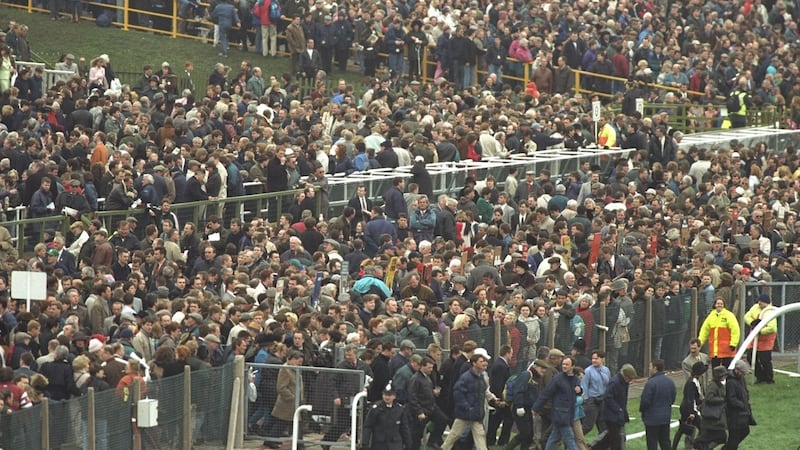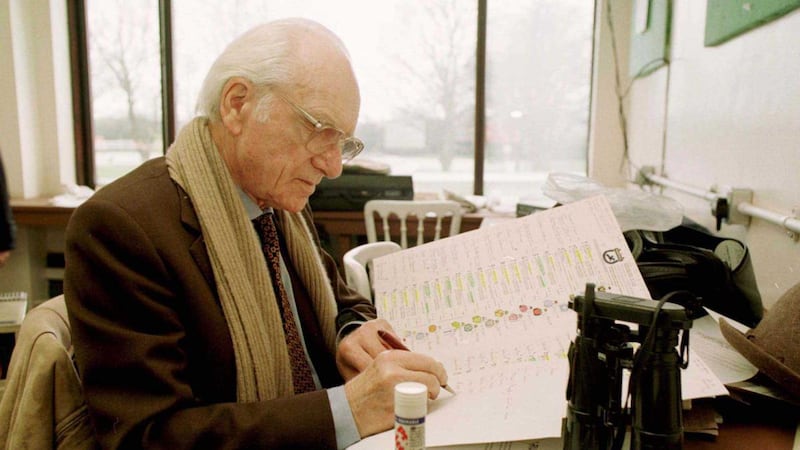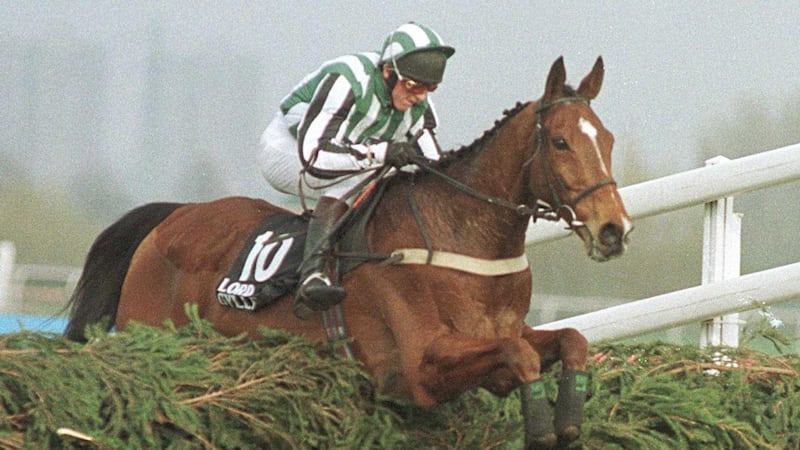The message came through Tony O’Hehir’s earpiece. It was blunt – everyone drop everything and get out of there.
‘There’ was the BBC’s commentary box next to Bechers Brook. A few minutes earlier the two of us had clambered into it up a notably rickety ladder ahead of the 150th Aintree Grand National.
Tony was continuing family tradition as part of the Beeb’s team for the world’s most famous steeplechase. His father, Michael, did his renowned ‘Foinavon’ commentary 30 years previously in 1967 from close by.
But mar-dhea he needed a ‘spotter’ to help identify fallers in the big race. So this rookie National hack got a badge into the best seat in the house overlooking racing’s most famous fence.
It was giddy stuff for someone all but weaned on the National and barely a wet week in The Irish Times racing gig.
Quantifying the link between the race and the job was impossible but it definitely existed.
Like so many others with no family link to either horses or racing it was the National that sparked childish fascination with both.
The colour and dash of the longest race of all over the biggest fences of all, and the fact that even parents who didn’t know The Pilgarlic from a piebald darkened a bookies door to bet on it, made it different.
Everyone watched the National, roaring at the telly, groaning when their sweep pick fell, or shouting with exasperation that effing Spanish Steps hadn’t got a mention in ages. There’s nothing to beat adults acting like kids to make children take notice.
Soon nothing could top watching re-runs of Red Rum running down Crisp. Or Red Rum stuffing L’Escargot and then getting stuffed in turn by the fastest snail ever to look through a pair of blinkers.
By the time Rummy completed his hat-trick in 1977, to a soundtrack of Peter O’Sullevan announcing that you’ve never heard the like of it in Liverpool, the racing tick had burrowed in deeply, never to get dug out.
So, as Tony had a final scan of the jockeys’ colours, yours truly was all but pinching himself, looking directly at the iconic Bechers Brook, waiting for a first National in the flesh, but pretending to be both eagle-eyed and useful.

However, even from half a mile away no binoculars were needed to suddenly spot more than 60,000 people start to pour out from the Aintree stands. They moved with a speed that indicated something was seriously wrong. They quickly thronged the enclosures. Then they waited.
Today there would be any amount of immediate social media speculation or information to hand. Back then it was confusion. The phone signal had disappeared. What the hell was going on? And then came the message – get out of there.
The police had got two coded bomb warnings. Everyone was ordered onto a public highway as soon as possible. Just drop everything and go. Racing’s biggest day of the year turned into an evacuation. It beggared belief but there would be no National.
Instead there was nothing for it but to start walking. Rather than Go Ballistic, Lord Gyllene and the other National runners, it was thousands of disgruntled racegoers crossing the Melling Road.
Among some of them, mixed in with disappointment and incredulity, was anger. There were a few ragged chants of ‘No Surrender to the IRA’ as we tramped out of the racecourse. Much of it was beer-fuelled bravado. Nevertheless if you were Irish it felt a good time to keep your mouth shut.
Those working for Sunday newspapers were left scrambling for both information and any means of sending it back to base. Drop everything meant just that. The National jockeys weren’t even allowed change out of their silks. They too were left to make the best of it on Liverpool’s suburban streets.
Over two decades later it would be nice to be able to pretend the overall significance of it all was immediately obvious, that the implications for a still fledgling peace-process in the North of Ireland, or the upcoming British general election, dominated our journalistic thoughts.
But even in the most dramatic of circumstances there’s no interest like self-interest: our bags were in the Moat House Hotel in the city centre. Everyone had checked out that morning with the intention of picking up the gear on the way to the airport that evening. Now all plans were scrapped.
How the hell were we going to get back? More importantly how could we get back before everyone else? Having checked out, the race now was to check back in. Nobody was going anywhere now. Liverpool and the National was the biggest story of all.
Every Scouser on Merseyside appeared to be queuing at Aintree train station. There was nothing for it but to schlep towards the city centre.
All told the atmosphere was remarkably good-natured. One jockey still in silks was cheekily asked by a doorman as he eventually fetched up at the Adelphi Hotel – “Hey, mate, have you come straight from work?!” But it was a tense kind of levity.
Four years previously the National had thrown up an incredible scenario with a series of false starts leading to a race that never was. It was shambolic and embarrassing, leading to an infamous quote from one trainer that it wouldn’t happen even in a “backward little country like Ireland.”

This was altogether more sinister. Bomb threats issued with a recognised IRA code had led to the biggest ever evacuation of a sporting event. An event and a sport renowned for unifying millions of fans throughout Ireland and Britain had been vandalised for twisted political purposes.
It came on the back too of a much more personal disaster. Just five days previously, on Easter Monday, Shane Broderick, one of the best young jockeys in Ireland, had suffered catastrophic injuries in a fall at the Fairyhouse Irish Grand National meeting.
The implications of that spill, which left Broderick with a broken neck and a badly damaged spinal cord, were only beginning to be appreciated by the wider racing community. A sport famed for its toughness and resilience felt like it was being pummelled from all sides.
On the face of it though the mood didn’t feel particularly beleaguered in Liverpool that Saturday night. Some of the great and the good of Irish racing were among those determined to make the most of a bad lot in the Moat House. By some fluke I was there too. So was Peter O’Sullevan.
Racing’s ‘Voice’ had been due to make his 50th and final National broadcast that day. He was one of the last to leave the track too since no way was he leaving his famous U-Boat binoculars behind.
As part of the commentary elite he and O’Hehir were old pals. He invited Tony to his table in the restaurant. I was too dumb and star-struck not to take the hint and leave them be.
O’Sullevan was pessimistic about the 1997 Grand National going ahead. It was something to do with telly rights in the Far East, I think. But hearing that voice first-hand meant he might have been reading the menu. Sadly my own voice intruded too often.
There were rumours the National would be run on the Monday. Tony and I argued it had to be. With an election looming the authorities couldn’t be seen to give in. I remember insisting on that point more and more as the night wore on.
O’Sullevan eventually responded: ‘Yes, Brian, I can see where you’re coming from on this, but, frankly, what you’re saying is complete bollocks.’
I was stunned. Peter O’Sullevan knew my name. Peter O’Sullevan had sworn at ME – how cool was that!

Then to back up his point the great man, always famously fond of a bet, offered 5-2 to each of us about the race taking place on Monday.
Thankfully, and for once, his judgment was off. But it was touch and go. And nagging mortification at how the world’s most famous steeplechase was cancelled due to political entanglements in the home of steeplechasing was hard to dismiss.
The local response to it all was mostly exemplary. Many people, including stable staff who had been ordered away from their horses at the track, were taken in and fed by Liverpudlians in a rare display of kindness and generosity.
Some housed strangers overnight by which time they were greeted with belligerent Sunday tabloid headlines – “We’ll fight them on the Bechers” – that couldn’t besmirch all that spontaneous decency on the ground.
If anything the cartoon representations underlined how unreal the previous day’s events had seemed, although not enough to make anyone underestimate how frightening the situation had been. There had been real panic. Any bombast was subsequent to the event.
But for many visitors the overwhelming emotion was of embarrassment. At a time of rising national confidence in Ireland, having an international institution so cherished by so many in this country jarred dreadfully.
National Hunt racing in Ireland and Britain is a single organism in many ways, two sides of the same coin. Each needs the other. Both sides of the Irish border are a single racing jurisdiction. The biggest stars, both human and equine, are celebrated whatever the jurisdiction.
Racing’s Anglo-Irish rivalry is one thing; hostility very much another.
Trying to tease out such a jumble of emotions into some sort of coherent line made working on the Sunday no picnic. Teasing it out live on a number of interviews for various radio stations so desperate to fill airtime that they rang me was even less fun.
I seem to remember one shock-jock wannabe repeatedly demanding to know if I was ashamed to be Irish. The only shame was in not reheating O’Sullevan’s line to me from the previous night. Or not pointing out the obvious about how shame and embarrassment aren’t the same thing.
By then the decision to hold the National on its own, at 5.0pm on the Monday, had been made. There would be free entry to racegoers. About 10,000 were anticipated. Double that turned up. It added to a prevailing mood of defiance.
It emerged afterwards that more threats were made but were judged not to be credible. There was grim determination to get it over with, a dispiriting attitude to have to take into what is normally a raucously joyous occasion.
Lord Gyllene won the race, ridden by Tony Dobbin, originally from Downpatrick in Co Down. A couple of days before Dobbin too had spoken of being embarrassed by the course of events. Now he'd supplied a perfect positive riposte to those cynics who'd tried to destroy the great event.
Re-runs suggest Lord Gyllene was one of the most visually impressive National winners ever. He and Dobbin basically made all the running over four and a half miles and 30 fences and always looked in control.
But even such a performance was never going to be able to jostle aside the unfortunate circumstances in which it took place.











